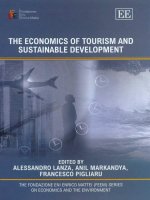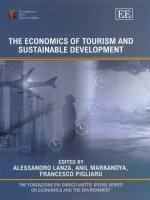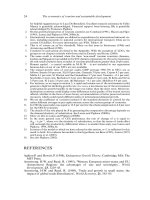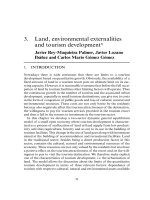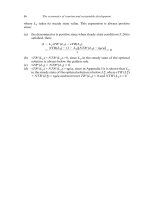THE ECONOMICS OF MONEY,BANKING, AND FINANCIAL MARKETS 180
Bạn đang xem bản rút gọn của tài liệu. Xem và tải ngay bản đầy đủ của tài liệu tại đây (58.55 KB, 1 trang )
PA R T I I
148
Financial Markets
Adaptive Expectations
FYI
The adaptive expectations hypothesis can be
stated as follows
x te
x te
1
x te 1 ), 0
u(xt
u
1
also known as the error-learning hypothesis.
Equation 7 can be written as
x et
(7)
(1
xt
)x te
1
and by continuous back substitution yields
where x t is the value of x at time t and x te is
the expected value of x for period t 1, with
the expectation held at time t. Equation 7
says that the change in the expected value of
x, x et
x et 1, is proportional to the forecast
error, which is the discrepancy between the
current actual and last period s expected
value of x.
if expectations realize (i.e., xt
then x et
x et 1
x
e
t
),
1
if x turns out to be surprisingly high (i.e.,
xt x et 1), then x et x et 1
if x turns out to be surprisingly low (i.e.,
xt x et 1), then x et x et 1
Clearly, the formulation in Equation 7
expresses the ability of economic agents to
learn from their past mistakes. This is why it is
x et
xt
(1
)x t
1
(1
)2 x t
2
....
In short, the adaptive expectation hypothesis implies that the expected value of x at time
t, xte, is a weighted average of current and past
values of x. The weighting scheme can be
thought of as a memory. In fact,
as u * 0, the weights decline slowly and the
economic agent is said to have long memory, in the sense that information from the
distant past influences significantly the formation of expectations for the future.
as u * 1, the weights decline quickly and the
economic agent is said to have short memory, in the sense that only information from
the recent past influences the formation of
expectations for the future.
can be stated as follows: Expectations will be identical to optimal forecasts
(the best guess of the future) using all available information.2
What exactly does this mean? To explain it more clearly, let s use the theory of
rational expectations to examine how expectations are formed in a situation that
most of us encounter at some point in our lifetimes: our drive to work. Suppose
that when Joe Commuter travels when it is not rush hour, it takes an average of
30 minutes for his trip. Sometimes it takes him 35 minutes, other times 25 minutes,
but the average non rush-hour driving time is 30 minutes. If, however, Joe leaves
for work during the rush hour, it takes him, on average, an additional 10 minutes
to get to work. Given that he leaves for work during the rush hour, the best guess
of the driving time the optimal forecast is 40 minutes.
If the only information available to Joe before he leaves for work that would
have a potential effect on his driving time is that he is leaving during the rush hour,
what does rational expectations theory allow you to predict about Joe s expecta-
2
John Muth, Rational Expectations and the Theory of Price Movements, Econometrica 29 (1961):
315 335.





